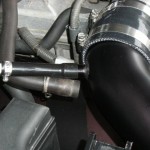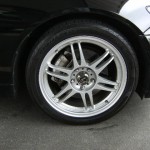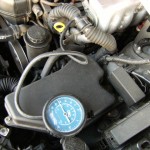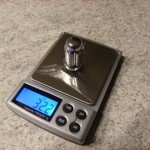Popular Posts
- Don't Block or Remove the EGR Valve, It's Saving You Money
- Keep Your Engine Alive: The Importance of Oil Temperature
- Low Temp Thermostats: What's the Advantage?
- Wheel Tech, Part III: Wheel Diameter's Effect on Performance
- Beating the Heat: Advantage of a High Pressure Radiator Cap
- How to Compare Weight Savings to Horsepower Gains
- Check Your Engine's Health: With a Vacuum Gauge
- Wheel Tech, Part II: Width Matters
- What's So Wrong With Nitrous?
- Stiff Stuff: Strut Bars and Braces
Resources & Classes
-
Monthly Archives: May 2011
Intelligent Modification: Doing Some Intake Mods on Project Lexus
 Last time I showed you how I measured the intake restriction on project Lexus. Hopefully seeing how easy it is done has now inspired you to go out and take some measurements of your own.
Last time I showed you how I measured the intake restriction on project Lexus. Hopefully seeing how easy it is done has now inspired you to go out and take some measurements of your own.
Let's Review
So before we get started, let me quickly review some of what we learned in the past two articles. First of all, we discussed how you can use a vacuum gauge or differential pressure meter to measure intake restriction.
I then showed you on the IS300 exactly how I tapped the intake system in various places to determine where the intake restriction was. Anywhere I tapped the intake system I knew that the restriction from that point FORWARD (towards the front of the intake system - ie the snorkel and in fact, the open atmosphere).
I also told you that, surprisingly, the IS300s intake system is actually quite good even in completely stock form. The total pressure drop on this car, with a bone stock intake system was only -9.1 inches of water (among one of the better stock systems I've measured). This pressure drop was measured on a previously modified engine as well. This means that if anything, the pressure drop on our car would be higher than or equal to the stock car. I suspect it would be the same. (more…)
Posted in Engine
3 Comments
Intelligent Modification: Measuring The Intake Restriction on Project Lexus (Part II)
 In the last article, I told you that you can easily measure intake restriction using a differential pressure gauge (or simply a vacuum gauge).
In the last article, I told you that you can easily measure intake restriction using a differential pressure gauge (or simply a vacuum gauge).
For whatever reason, nearly no one does this, and it's a shame, as it'd save most people a grip of cash and probably show them that some of the things they've done in the name of performance, didn't actually accomplish much at all - or perhaps also, that it accomplished quite a lot.
I don't like to waste money, and I like to be able to quantify for certain what changes I've made when I do a mod. In this article, I am going to show you how I measured the intake restriction on a 2002 Lexus IS300. However, you can follow these exact steps on ANY car, regardless of the year, make or model. (more…)
Posted in Engine
2 Comments
Keep Your Engine Alive: The Importance of Oil Temperature
 One of the things you will find if you have a oil pressure or temperature gauge is that regardless of the fact that oil is running through your engine and cooling it just like the coolant - it takes on and loses heat differently than coolant.
One of the things you will find if you have a oil pressure or temperature gauge is that regardless of the fact that oil is running through your engine and cooling it just like the coolant - it takes on and loses heat differently than coolant.
Oil temperature is probably the most important thing to know, specifically for those of us who are pushing our cars hard. Free reving (or worse - racing) on an engine that has not fully reached it's oil operating temperature is extremely dangerous. But don't think that the coolant gauge will tell you this information - it won't.
As a general rule of thumb, after the car is warmed up, oil tends to be a few degrees warmer than the coolant (usually 10-15 degrees Fahrenheit).
However, it takes much longer for oil to come up to temperature than coolant. When you start your car in the morning, most of us are wise enough to not romp on the car until the coolant gauge is up to operating temperature. This is certainly better than romping on it cold, but it's still not quite ideal.
You see, the oil, especially in colder ambient temperatures, takes several times longer to come up to temperature.
Oil will not get to complete operating temperature easily by simply idling, it requires driving around and putting SOME load on the engine. I see people in the pits at races all the time reving their motors to 'warm the engine up'. It won't do any good and is only putting premature wear on the car.
The best way to get a car's oil temperature up is to simply drive it around for a few minutes. Ideally you'd have an oil temperature gauge to tell you when it's at operating temperature - and oil pressure gauge (lower pressure) would also tell you this information.
What's the danger of running an engine cold?
Total engine failure.
Posted in Engine
2 Comments
Blending In: Making Aftermarket Wheels Look “Factory”
 While some people want the "modified" look, others prefer to keep a lower profile.
While some people want the "modified" look, others prefer to keep a lower profile.
I'm one of them, as when I'm stopped by a police officer, I don't want them saying "boy racer" as they approach the car--not the best first impression. I'm always humored when folks complain that they were stopped for an exhaust or whatever. It may be "profiling" or "harassment" but, unfortunately, just because it isn't totally fair doesn't mean it is ever going to stop.
Even if you don't care about the attention of authorities, perhaps you don't want every other boy racer in their rice mobile revving at you at every traffic light in town.
One of the ways that you can disguise your modifications is to make your aftermarket wheels blend in better. It also tends to be better looking to the average person and gives your car that "factory tuned" appearance when done right.
Posted in Sleeper Tech
5 Comments
Intelligent Modification: Measuring Intake Restriction (Part I)
 Measuring intake restriction allows you to pinpoint the exact point in your intake system where restriction is occurring and then decide how to best address that restriction. The typical way we deal with restriction in an intake system is just to replace the whole thing with a (usually) expensive intake system.
Measuring intake restriction allows you to pinpoint the exact point in your intake system where restriction is occurring and then decide how to best address that restriction. The typical way we deal with restriction in an intake system is just to replace the whole thing with a (usually) expensive intake system.
However, in many cases, the factory air box could very inexpensively be modified to create the same or better gains than a fancy aftermarket intake. In fact, you'd be surprised to find out that in the real world (ie, not on a dyno but on a real road) that most intake systems do not provide anywhere near the gains they claim. Many in fact, actually hurt your power production - in the real world.
If you ask on a forum which intake is best, you'll get a hundred opinions and people swearing up and down that this intake is better than that one or whatever. However, if you want hard facts from any of them - you'll be met with more e-Facts than anything.
Dyno results are often very deceptive as they are measuring the horsepower output of a car that is strapped to rollers, not moving down the road where aerodynamic forces play a much bigger role than many enthusiasts realize, and with the hood open instead of holding in all that hot air from the radiator and exhaust system. The motivation of the aftermarket part seller is to sell more parts - therefore, they are not always completely honest about their dynos. People on the forums are also not always entirely honest, as many want to believe their car is faster than it is and they've spent money on this intake or exhaust - they want to justify their purchase! No one likes to look foolish.
So what is a wise enthusiast to do? Well, take actual measurements - that's what!
Posted in Engine
8 Comments
Check Your Engine’s Health: With a Vacuum Gauge
 One of the easiest and cheapest ways to check an engine for serious issues is to use a plain ole vacuum gauge. A vacuum gauge can tell you a lot about an engine's condition, similar to a full leak down test - but in a much easier way. In just 3-5 minutes you can know if an engine is healthy or not.
One of the easiest and cheapest ways to check an engine for serious issues is to use a plain ole vacuum gauge. A vacuum gauge can tell you a lot about an engine's condition, similar to a full leak down test - but in a much easier way. In just 3-5 minutes you can know if an engine is healthy or not.
For those of you modifying your engine, I think it makes a lot of sense to make sure your engine is in top notch shape before spending money on modifications, especially if you're working on a high mileage car. Making sure the engine is making at least stock horsepower before you spend more money on it is a very sensible thing if you ask me.
Vacuum gauges are often forgotten in this age of OBDII scanners and other specialized tools, but a vacuum gauge can VERY quickly tell you whether or not your engine (or one in a car you're about to buy!) is good, or ready to die.
Posted in Engine
3 Comments
Rediculous Mods: The Problem with Lightweight Lug Nuts
 First of all, I apologize for missing last Friday's post. I was quite busy last week but I plan to bring you two great articles this week, starting with today's article. Without further delay, let's get going...
First of all, I apologize for missing last Friday's post. I was quite busy last week but I plan to bring you two great articles this week, starting with today's article. Without further delay, let's get going...
There are a number of products marketed to automotive enthusiasts that are so ridiculous it's a wonder that they actually sell. However, as many of you, I am often tempted by the bright and shiny - so hopefully this article will steer you clear of at least one silly modification.
Lightweight lug nuts are perhaps some of more useless items being sold to guys who seem to think that 'every little bit counts' (which is sort of like being penny wise but pound foolish - look that phrase up if you're not familiar). While small things can add up, for most enthusiasts with actual wallets to think about, I like to focus on the big bang for my buck type stuff.
Why are lightweight lug nuts ridiculous?
Posted in Rediculous Mods
1 Comment
